Conservation and restoration of cultural heritage
The conservation and restoration of cultural heritage focuses on protection and care of tangible cultural heritage, including artworks, architecture, archaeology, and museum collections.[1] Conservation activities include preventive conservation, examination, documentation, research, treatment, and education.[2] This field is closely allied with conservation science, curators and registrars.
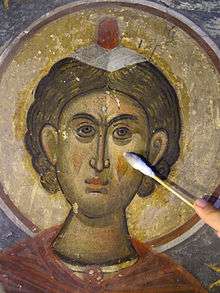
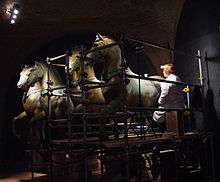
Definition
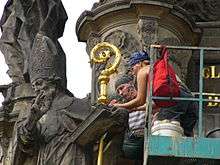
Conservation of cultural heritage involves protection and restoration using "any methods that prove effective in keeping that property in as close to its original condition as possible for as long as possible."[3] Conservation of cultural heritage is often associated with art collections and museums and involves collection care and management through tracking, examination, documentation, exhibition, storage, preventive conservation, and restoration.[4]
The scope has widened from art conservation, involving protection and care of artwork and architecture, to conservation of cultural heritage, also including protection and care of a broad set of other cultural and historical works. Conservation of cultural heritage can be described as a type of ethical stewardship.
Conservation of cultural heritage applies simple ethical guidelines:
- Minimal intervention;
- Appropriate materials and reversible methods;
- Full documentation of all work undertaken.
Often there are compromises between preserving appearance, maintaining original design and material properties, and ability to reverse changes. Reversibility is now emphasized so as to reduce problems with future treatment, investigation, and use.
In order for conservators to decide upon an appropriate conservation strategy and apply their professional expertise accordingly, they must take into account views of the stakeholder, the values, artist’s intent, meaning of the work, and the physical needs of the material.
Cesare Brandi in his Theory of Restoration, describes restoration as "the methodological moment in which the work of art is appreciated in its material form and in its historical and aesthetic duality, with a view to transmitting it to the future".[5]
History
Key dates
Some consider the tradition of conservation of cultural heritage in Europe to have begun in 1565 with the restoration of the Sistine Chapel frescoes, but more ancient examples include the work of Cassiodorus.[6]
Brief history
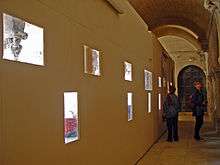
The care of cultural heritage has a long history, one that was primarily aimed at fixing and mending objects for their continued use and aesthetic enjoyment.[7] Until the early 20th century, artists were normally the ones called upon to repair damaged artworks. During the 19th century, however, the fields of science and art became increasingly intertwined as scientists such as Michael Faraday began to study the damaging effects of the environment to works of art. Louis Pasteur carried out scientific analysis on paint as well.[8] However, perhaps the first organized attempt to apply a theoretical framework to the conservation of cultural heritage came with the founding in the United Kingdom of the Society for the Protection of Ancient Buildings in 1877. The society was founded by William Morris and Philip Webb, both of whom were deeply influenced by the writings of John Ruskin. During the same period, a French movement with similar aims was being developed under the direction of Eugène Viollet-le-Duc, an architect and theorist, famous for his restorations of medieval buildings.
Conservation of cultural heritage as a distinct field of study initially developed in Germany, where in 1888 Friedrich Rathgen became the first chemist to be employed by a Museum, the Koniglichen Museen, Berlin (Royal Museums of Berlin). He not only developed a scientific approach to the care of objects in the collections, but disseminated this approach by publishing a Handbook of Conservation in 1898.[10] The early development of conservation of cultural heritage in any area of the world is usually linked to the creation of positions for chemists within museums. In British archaeology, key research and technical experimentation in conservation was undertaken by women such as Ione Gedye both in the field and in archaeological collections, particularly those of the Institute of Archaeology, London.
In the United Kingdom, pioneering research into painting materials and conservation, ceramics, and stone conservation was conducted by Arthur Pillans Laurie, academic chemist and Principal of Heriot-Watt University from 1900. Laurie's interests were fostered by William Holman Hunt.[11] In 1924 the chemist Dr Harold Plenderleith began to work at the British Museum with Dr. Alexander Scott in the recently created Research Laboratory, although he was actually employed by the Department of Scientific and Industrial Research in the early years. Plenderleith's appointment may be said to have given birth to the conservation profession in the UK, although there had been craftsmen in many museums and in the commercial art world for generations.[12] This department was created by the museum to address the deteriorating condition of objects in the collection, damages which were a result of their being stored in the London Underground tunnels during the First World War. The creation of this department moved the focus for the development of conservation theory and practice from Germany to Britain, and made the latter a prime force in this fledgling field. In 1956 Plenderleith wrote a significant handbook called The Conservation of Antiquities and Works of Art, which supplanted Rathgen's earlier tome and set new standards for the development of art and conservation science.
In the United States, the development of conservation of cultural heritage can be traced to the Fogg Art Museum, and Edward Waldo Forbes, its director from 1909 to 1944. He encouraged technical investigation, and was Chairman of the Advisory Committee for the first technical journal, Technical Studies in the Field of the Fine Arts, published by the Fogg from 1932 to 1942. Importantly he also brought onto the museum staff chemists. Rutherford John Gettens was the first of such in the US to be permanently employed by an art museum. He worked with George L. Stout, the founder and first editor of Technical Studies. Gettens and Stout co-authored Painting Materials: A Short Encyclopaedia in 1942, reprinted in 1966. This compendium is still cited regularly. Only a few dates and descriptions in Gettens' and Stout's book are now outdated.[13]
George T. Oliver, of Oliver Brothers Art Restoration and Art Conservation-Boston (Est. 1850 in New York City) invented the vacuum hot table for relining paintings in 1920s; he filed a patent for the table in 1937.[14] Taylor's prototype table, which he designed and constructed, is still in operation. Oliver Brothers is believed to be the first and the oldest continuously operating art restoration company in the United States.
The focus of conservation development then accelerated in Britain and America, and it was in Britain that the first International Conservation Organisations developed. The International Institute for Conservation of Historic and Artistic Works (IIC) was incorporated under British law in 1950 as "a permanent organization to co-ordinate and improve the knowledge, methods, and working standards needed to protect and preserve precious materials of all kinds."[13] The rapid growth of conservation professional organizations, publications, journals, newsletters, both internationally and in localities, has spearheaded the development of the conservation profession, both practically and theoretically. Art historians and theorists such as Cesare Brandi have also played a significant role in developing conservation science theory. In recent years ethical concerns have been at the forefront of developments in conservation. Most significantly has been the idea of preventive conservation. This concept is based in part on the pioneering work by Garry Thomson CBE, and his book the Museum Environment, first published in 1978.[15] Thomson was associated with the National Gallery in London; it was here that he established a set of guidelines or environmental controls for the best conditions in which objects could be stored and displayed within the museum environment. Although his exact guidelines are no longer rigidly followed, they did inspire this field of conservation.
Ethics
The conservator's work is guided by ethical standards. These take the form of applied ethics. Ethical standards have been established across the world, and national and international ethical guidelines have been written. One such example is:
- American Institute for Conservation Code of Ethics and Guidelines for Practice[16]
Conservation OnLine provides resources on ethical issues in conservation,[17] including examples of codes of ethics and guidelines for professional conduct in conservation and allied fields; and charters and treaties pertaining to ethical issues involving the preservation of cultural property.
As well as standards of practice conservators deal with wider ethical concerns, such as the debates as to whether all art is worth preserving.[18]
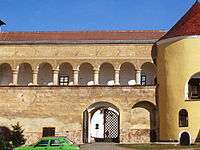
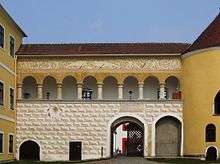
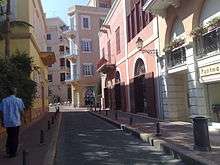
Caring for cultural heritage
Collections care
Many cultural works are sensitive to environmental conditions such as temperature, humidity and exposure to visible light and ultraviolet radiation. These works must be protected in controlled environments where such variables are maintained within a range of damage-limiting levels. For example, watercolour paintings usually require shielding from sunlight to prevent fading of pigments.
Collections care is an important element of museum policy. It is an essential responsibility of members of the museum profession to create and maintain a protective environment for the collections in their care, whether in store, on display, or in transit. A museum should carefully monitor the condition of collections to determine when an artifact requires conservation work and the services of a qualified conservator.
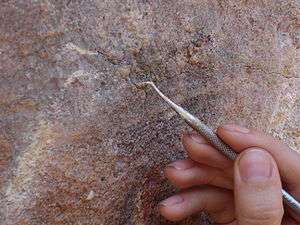
Interventive conservation
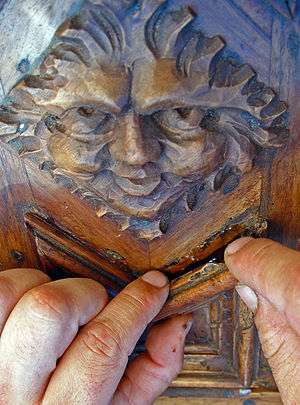
A teaching programme of interventive conservation was established in the UK at the Institute of Archaeology by Ione Gedye, which is still teaching interventive conservators today.[19]
A principal aim of a cultural conservator is to reduce the rate of deterioration of an object. Both non-interventive and interventive methodologies may be employed in pursuit of this goal. Interventive conservation refers to any direct interaction between the conservator and the material fabric of the object. Interventive actions are carried out for a variety of reasons, including aesthetic choices, stabilization needs for structural integrity, or cultural requirements for intangible continuity. Examples of interventive treatments include the removal of discolored varnish from a painting, the application of wax to a sculpture, and the washing and rebinding of a book. Ethical standards within the field require that the conservator fully justify interventive actions and carry out documentation before, during, and after the treatment.
One of the guiding principles of conservation of cultural heritage has traditionally been the idea of reversibility, that all interventions with the object should be fully reversible and that the object should be able to be returned to the state in which it was prior to the conservator's intervention. Although this concept remains a guiding principle of the profession, it has been widely critiqued within the conservation profession[20] and is now considered by many to be "a fuzzy concept."[21] Another important principle of conservation is that all alterations should be well documented and should be clearly distinguishable from the original object.[22]
An example of a highly publicized interventive conservation effort would be the conservation work conducted on the Sistine Chapel.
Conservation laboratories
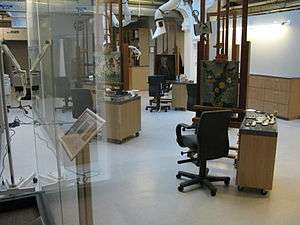
Conservators routinely use chemical and scientific analysis for the examination and treatment of cultural works. The modern conservation laboratory uses equipment such as microscopes, spectrometers, and various x-ray regime instruments to better understand objects and their components. The data thus collected helps in deciding the conservation treatments to be provided to the object.
Country by country look
United States
Heritage Preservation, in partnership with the Institute of Museum and Library Services, a U.S. federal agency, produced The Heritage Health Index. The results of this work was the report A Public Trust at Risk: The Heritage Health Index Report on the State of America's Collections, which was published in December 2005 and concluded that immediate action is needed to prevent the loss of 190 million artifacts that are in need of conservation treatment. The report made four recommendations:
- Institutions must give priority to providing safe conditions for the collections they hold in trust.
- Every collecting institution must develop an emergency plan to protect its collections and train staff to carry it out.
- Every institution must assign responsibility for caring for collections to members of its staff.
- Individuals at all levels of government and in the private sector must assume responsibility for providing the support that will allow these collections to survive.[23]
United Kingdom
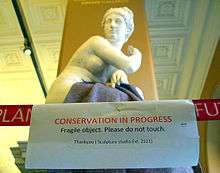
In October 2006, the Department for Culture, Media and Sport, a governmental department, authored a document: "Understanding the Future: Priorities for England's Museums".[24] This document was based on several years of consultation aimed to lay out the government's priorities for museums in the 21st century.
The document listed the following as priorities for the next decade:
- Museums will fulfil their potential as learning resources (pp 7–10).
- Museums will be embedded into the delivery of education in every school in the country.
- Understanding of the effectiveness of museum education will be improved further and best practice built into education programmes.
- The value of museums' collections as a research resource will be well understood and better links built between the academic community and museums.
- Museums will embrace their role in fostering, exploring, celebrating and questioning the identities of diverse communities (pp 11–14).
- The sector needs to work with partners in academia and beyond to create an intellectual framework supporting museums' capacity to tackle issues of identity.
- The museum sector must continue to develop improved practical techniques for engaging communities of all sorts.
- Museums' collections will be more dynamic and better used (pp 15–18).
- Government and the sector will find new ways to encourage museums to collect actively and strategically, especially the record of contemporary society.
- The sector will develop new collaborative approaches to sharing and developing collections and related expertise.
- Museums' workforce will be dynamic, highly skilled and representative (pp 17–22).
- Museums' governing bodies and workforce will be representative of the communities they serve.
- Find more varied ways for a broader range of skills to come into museums.
- Improve continuing professional development.
- Museums will work more closely with each other and partners outside the sector (pp 23–26).
- A consistent evidence base of the contribution of all kinds of museums to the full range of public service agendas will be developed.
- There will be deeper and longer lasting partnerships between the national museums and a broader range of regional partners.
- Museums' international roles will be strengthened to improve museum programmes in this country and Britain's image, reputation and relationships abroad.
The conservation profession response to this report was on the whole less than favourable, the Institute of Conservation (ICON) published their response under the title "A Failure of Vision".[25] It had the following to say:
"No sector can look with confidence to the future if its key asset is worked harder and harder across an ever broadening range of objectives while the inputs required to sustain it are neglected."
"It is of major concern to us that the only part of this section which makes any acknowledgement of the need for greater resourcing is the part which refers to acquisitions. The original consultation paper made quite extensive reference to the importance of collections, the role of new technologies, and cultural property issues, but this appears to have been whittled away in the present document."
Concluding:
"When asked by the Commons Culture Media and Sport elect Committee CMS committee what he would like to see as a priority in the DCMS document arising from the 'Understanding the Future' consultation, Mr MacGregor responded 'I would like to see added there the need to conserve and research the collections, so that the collections can really play the role across the whole of the United Kingdom that they should.' So would we."
Further to this the ICON website summary report[26] lists the following specific recommendations:
- A national survey to find out what the public want from museums, what motivates them to visit them and what makes for a rewarding visit.
- A review of survey results and prioritisation of the various intrinsic, instrumental and institutional values to provide a clear basis for a 10-year strategy
- HR consultants to be brought in from the commercial sector to review recruitment, career development and working practices in the national and regional museums.
- A commitment to examine the potential for using Museum Accreditation as a more effective driver for improving recruitment, diversity, and career development across the sector.
- DCMS to take full account of the eventual findings of the current Commons Select Committee enquiry into Care of Collections in the final version of this document
- The adoption of those recommendations of the recent House of Lords inquiry into Science and Heritage which might affect the future of museums.
In November 2008, the UK-based think tank Demos published an influential pamphlet entitled It's a material world: caring for the public realm,[27] in which they argue for integrating the public directly into efforts to conserve material culture, particularly that which is in the public, their argument, as stated on page 16, demonstrates their belief that society can benefit from conservation as a paradigm as well as a profession:
"conservators provide a paradigm not just for fixing things when they are broken, but for a wider social ethos of care, where we individually and collectively take responsibility and action"
Training
Training in conservation of cultural heritage for many years took the form of an apprenticeship, whereby an apprentice slowly developed the necessary skills to undertake their job. For some specializations within conservation this is still the case. However, it is more common in the field of conservation today that the training required to become a practicing conservator comes from a recognized university course in conservation of cultural heritage.[28]
The University can rarely provide all the necessary training in first hand experience that an apprenticeship can, and therefore in addition to graduate level training the profession also tends towards encouraging conservation students to spend time as an intern.
Conservation of cultural heritage is an interdisciplinary field as conservators have backgrounds in the fine arts, sciences (including chemistry, biology, and materials science), and closely related disciplines, such as art history, archaeology, and anthropology. They also have design, fabrication, artistic, and other special skills necessary for the practical application of that knowledge.
Within the various schools that teach conservation of cultural heritage, the approach differs according to the educational and vocational system within the country, and the focus of the school itself. This is acknowledged by the American Institute for Conservation who advise "Specific admission requirements differ and potential candidates are encouraged to contact the programs directly for details on prerequisites, application procedures, and program curriculum".[28]
In France, training for heritage conservation is taught by four schools : École supérieure d'art d'Avignon, L’École supérieure des Beaux-Arts Tours, Angers, Le Mans, L’Université Paris 1, Institut national du patrimoine.[29]
Associations and professional organizations
Societies devoted to the care of cultural heritage have been in existence around the world for many years. One early example is the founding in 1877 of the Society for the Protection of Ancient Buildings in Britain to protect the built heritage, this society continues to be active today.[30] The 14th Dalai Lama and the Tibetan people work to preserve their cultural heritage with organizations including the Tibetan Institute of Performing Arts[31] and an international network of eight Tibet Houses.
The built heritage was at the forefront of the growth of member based organizations in the United States. Preservation Virginia, founded in Richmond in 1889 as the Association for the Preservation of Virginia Antiquities, was the United States' first statewide historic preservation group.[32]
Today, professional conservators join and take part in the activities of numerous conservation associations and professional organizations with the wider field, and within their area of specialization.
These organizations exist to "support the conservation professionals who preserve our cultural heritage".[33]
This involves upholding professional standards, promoting research and publications, providing educational opportunities, and fostering the exchange of knowledge among cultural conservators, allied professionals, and the public.
International cultural heritage documents
| Year | Document | Sponsor | Text (English where available) |
|---|---|---|---|
| 1931 | Athens Charter | International Congress of Architects and Technicians of Historic Monuments | text |
| 1931 | Carta Di Atene | Conferenza Internazionale di Atene | text (Italian) |
| 1932 | Carta Italiana del restauro | Consiglio Superiore Per Le Antichità e Belle Arti | text (Italian) |
| 1933 | Charter of Athens | IV CIAM | text |
| 1956 | New Delhi Recommendation | IX UNESCO | text, text |
| 1962 | Paris Recommendation | XII UNESCO | text |
| 1964 | Venice Charter | II International Congress of Architects and Technicians of Historic Monuments | text, text |
| 1964 | Paris Recommendation | XIII UNESCO | text |
| 1967 | Norms of Quito | OAS | text (Spanish), text |
| 1968 | Paris Recommendation | XV UNESCO | text |
| 1972 | Paris Convention | XVII UNESCO | text |
| 1972 | Paris Recommendation | XVII UNESCO | text |
| 1972 | Carta Italiana del Restauro | text (Italian) | |
| 1972 | Stockholm Declaration | UNEP | text |
| 1974 | Santo Domingo Resolution, Dominican Republic | Interamerican Seminar on the Conservation and Restoration of the Architectural Heritage of the Colonial and Republican Periods – OAS | text (Portuguese), text (Portuguese) |
| 1975 | Declaration of Amsterdam | Congress on the European Architectural Heritage | text |
| 1975 | European Charter of the Architectural Heritage | Council of Europe | text |
| 1976 | Charter on Cultural Tourism, Brussels | International Seminar on Contemporary Tourism and Humanism | text |
| 1976 | Nairobi Recommendation | XIX UNESCO | text |
| 1977 | Machu Picchu Charter | text (Portuguese), text (Portuguese), text (Spanish), ref (Spanish) | |
| 1981 | Burra Charter | ICOMOS | text |
| 1982 | Florence Charter | ICOMOS: Historic Gardens | text, text |
| 1982 | Nairobi Declaration | UNEP | text |
| 1982 | Tlaxcala Declaration | ICOMOS | text |
| 1982 | México Declaration | World Conference on Cultural Policies – MONDIACULT | text, text |
| 1983 | Declaration of Rome | ICOMOS | text |
| 1987 | Carta della conservazione e del restauro degli oggetti d'arte e di cultura | text (Italian) | |
| 1987 | Washington Charter | ICOMOS | text, text |
| 1989 | Paris Recommendation | XXV UNESCO | text |
| 1990 | Lausanne Charter | ICOMOS / ICAHM | text, text |
| 1994 | Nara Document | UNESCO / ICCROM / ICOMOS | text, text |
| 1995 | European Recommendation | Council of Europe, Committee of Ministers | text (Rec(95)3E),
text (Rec(95)9E) |
| 1996 | Declaration of San Antonio | ICOMOS | text |
| 1997 | Declaration of Sofia | XI ICOMOS or XXIX UNESCO | text |
| 1997 | Carta de Mar del Plata | Mercosur | text (Portuguese), text (Portuguese), text (Spanish), text (Spanish) |
| 2000 | Cracow Charter | text (Italian) | |
| 2002 | Declaration of Cartagena de Indias, Colômbia | Conselho Andino, OAS | text |
| 2003 | Paris Recommendation | XXXII UNESCO | text |
Example of an archaeological discovery and restoration of a mural painting
.jpg)
First archaeological search in the 19th-century layer by French archaeologist and restorer Yves Morvan .jpg)
Painting of the 15th century cleared before restoration 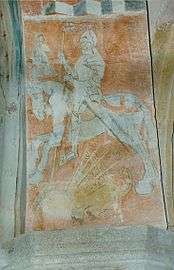
Painting after restoration
See also
- Wikipedia:WikiProject Collections Care
References
- Ann Marie Sullivan, Cultural Heritage & New Media: A Future for the Past, 15 J. MARSHALL REV. INTELL. PROP. L. 604 (2016) https://repository.jmls.edu/cgi/viewcontent.cgi?article=1392&context=ripl
- "Definition of a Profession". International Council of Museums - Committee for Conservation. Retrieved 18 August 2012.
- Walston, S. (1978). "The Preservation and Conservation of Aboriginal and Pacific Cultural Material in Australian Museums". ICCM Bulletin. 4 (1): 9. doi:10.1179/iccm.1978.4.4.002. Archived from the original on 2016-03-23. Retrieved 2012-06-29.
- Szczepanowska, Hanna M.. 2013. Conservation of cultural heritage: key principles and approaches. Routledge. ISBN 978-0415674744.
- [Cesare Brandi, Teoria del restauro; Rome: Edizioni di Storia e Letteratura, 1963: reprint, Turin: G. Einaudi, 1977]
- Pergoli Campanelli, Alessandro (2013). Cassiodoro alle origini dell'idea di restauro. Milano: Jaca book. p. 140. ISBN 978-88-16-41207-1.
- Pye, E, 2001. Caring for the Past: Issues in Conservation for Archaeology and Museums. London: James and James
- Stoner, Joyce Hill. 2005. p. 41. “Changing Approaches in Art Conservation: 1925 to the present” in (Sackler NAS Colloquium) Scientific Examination of Art: Modern Techniques in Conservation and Analysis. Proceedings of the National Academy of Sciences.
- "Art Under Wraps", Harvard Magazine, March–April 2000
- Gilberg, Mark. (1987). "Friedrich Rathgen: The Father of Modern Archaeological Conservation". Journal of the American Institute for Conservation. 26 (2): 105–120. doi:10.2307/3179459. JSTOR 3179459. Archived from the original on 2011-10-08. Retrieved 2010-05-25.
- "Brief biography of Professor AP Laurie". Archived from the original on 2012-07-14.
- History. British Museum (2012-06-14). Retrieved on 2012-06-29.
- Stoner, Joyce Hill. "Changing Approaches in Art Conservation: 1925 to the present". The publication exists in two editions. The earlier one is "Scientific Examination of Art: Modern Techniques on Conservation and Analysis" and was published by the National Academy of Sciences in 2003. The later edition of the publication is "Arthur M. Sackler Colloquia: Scientific Examination of Art: Modern Techniques in Conservation and Analysis". It was published by the National Academies Press in 2005.
- Patent# 2,073,802 U.S. "Art of Oil Painting Restoration", March 16, 1937. Patft1.uspto.gov. Retrieved on 2012-06-29.
- Museum Environment (2nd Edition), 1986, by Garry Thomson CBE ISBN 978-0-7506-2041-3
- AIC – Code of Ethics. Conservation-us.org. Retrieved on 2012-06-29.
- "Ethical issues in conservation". Conservation OnLine (CoOL). cool.conservation-us.org. Retrieved 2017-05-29.
- Weil, Stephen E. (October 1989). "Too much Art?". ArtNews: 232. ISSN 0004-3273.
- Pye, Elizabeth; Brommelle, Norman (January 1977). "A Tribute to Ione Gedye". The Conservator. 1 (1): 3–4. doi:10.1080/01400096.1977.9635631. ISSN 0140-0096.
- Andrew Oddy and Sara Carroll (eds). 1999. Reversibility – Does it Exist? British Museum Occasional Paper Number 135. London: British Museum.
- p. 185. Muñoz-Viñas, Salvador. 2005. Contemporary Theory of Conservation. London: Elsevier/Butterworth Heinemann.
- ICOM-CC International Council of Museums Committee for Conservation]
- Heritage Health Index Archived 2011-02-26 at the Wayback Machine. Heritagepreservation.org. Retrieved on 2012-06-29.
- Understanding the Future: Priorities for England’s Museums Archived 2008-10-23 at the Wayback Machine. Department for Culture, Media and Sport. culture.gov.uk. October 2006
- Understanding the Future: Priorities for England’s Museums. The Institute of Conservation. icon.org.uk
- The Future of Museums: A Failure of Vision. Icon.org.uk. Retrieved on 2012-06-29.
- Holden, John. and Samuel Jones. 2008. It's A Material World: Caring for the public realm. London: Demos.
- AIC – Becoming a Conservator. Conservation-us.org. Retrieved on 2012-06-29.
- "Formation initiale - Ministère de la Culture".
- History of the SPAB Archived 2008-05-16 at the Wayback Machine. Retrieved on 2012-06-29.
- "TIPA". tibet.net/. Central Tibetan Administration. Retrieved 26 September 2019.
- APVA Preservation Virginia Archived 2008-06-13 at the Wayback Machine. Apva.org. Retrieved on 2012-06-29.
- About AIC – Overview. Conservation-us.org. Retrieved on 2012-06-29.
Further reading
- Ann Marie Sullivan, Cultural Heritage & New Media: A Future for the Past, 15 J. MARSHALL REV. INTELL. PROP. L. 604 (2016) https://repository.jmls.edu/cgi/viewcontent.cgi?article=1392&context=ripl
- Charola, A. Elena, and Robert J. Koestler, eds. Pesticide Mitigation in Museum Collections: Science in Conservation: Proceedings from the MCI Workshop Series. Smithsonian Contributions to Museum Conservation, no. 1. Washington, D.C.: Smithsonian Institution Scholarly Press, 2010. Copies of this volume are available for free pdf download from the Smithsonian's digital library by clicking on the included link.
- Koestler, Robert J. et al., editors (2003). Art, biology, and conservation: biodeterioration of works of art. New York: The Metropolitan Museum of Art. ISBN 978-1588391070.CS1 maint: multiple names: authors list (link)
- Pergoli Campanelli, Alessandro, La nascita del restauro. Dall'antichità all'alto medioevo, Milan, Jaca book 2015 ISBN 9788816412996 .
- Sandis, Constantine, ed. 'Cultural heritage Ethics: Between Theory and Practice. Cambridge: Open Book Publishers, 2014. ISBN 978-1-78374-067-3
- Staniforth, Sarah, ed. Historical Perspectives on Preventive Conservation. Los Angeles: Getty Publications, 2013. ISBN 978-1-60606-142-8
- H. M. Szczepanowska, D. Jha, T. G. Mathia, eds. Morphology and characterization of Dematiaceous fungi on a cellulose paper substrate using synchrotron X-ray microtomography, scanning electron microscopy and confocal laser scanning microscopy in the context of cultural heritage, Journal of Analytical Atomic Spectrometry, 2015
External links
| Wikimedia Commons has media related to Conservation-restoration. |
- ATA Online, Abstracts of International Conservation Literature
- BCIN, the Bibliographic Database of the Conservation Information Network
- CAMEO: Conservation and Art Materials Encyclopedia OnLine
- Conservation OnLine (CoOL) Resources for Conservation Professionals, "CoOL, an online resource operated by the Foundation of the American Institute for Conservation is a full text library of conservation information, covering a wide spectrum of topics of interest to those involved with the conservation of library, archives and museum materials. It is a growing online resource for conservators, collection care specialists, and other conservation professionals."
- Grimwade Centre for Cultural Materials Conservation, a Department of Melbourne University.
- DOCAM — Documentation and Conservation of the Media Arts Heritage "to address the issues of preserving and documenting digital, technological and electronic works of art."
- Hornemann Institute of the HAWK Hochschule für angewandte Wissenschaft und Kunst (University of Applied Sciences and Arts) Hildesheim/Holzminden/Göttingen which provides E-Publications, mostly of European students and online courses in the field of heritage conservation as well as links to other conservation-related Websites.
- ICOMOS Open Archive: both an institutional archive of the scientific documentation produced by the International Council on Monuments and Sites (ICOMOS) and also a subject archive open to the entire international scientific community in the field of heritage conservation.
- Integrated Pest Management Working Group Website
- International Council of Museums (ICOM) Code of Ethics for Museums, 2006
- Indigo Arts Alliance/ Network, News, Listings and Grants for Conservators
- museumkids/What is Art Conservation? – The Metropolitan Museum of Art, 2001.
- Research Resources at the Getty Conservation Institute, including the AATA (formerly "Art and Archaeology Technical Abstracts") search engine, bibliographies for various topics, cultural heritage policy documents, and links to other conservation-related Web sites.
- Caring for Heritage Collections Online Course. An online course in preventive conservation issues for museum professionals, University of Melbourne, School of Historical Studies: Centre for Cultural Materials Conservation.
- Centre de recherche et de restauration des Musées de France, C2RMF on Wikipedia (in French)
- Theory and practice of conservation .
- Scholarly journals
- Journal of the American Institute for Conservation
- ICOM-CC Ethnographic Newsletter
- Victoria and Albert Museum Conservation Journal
- Journal of Conservation and Museum Studies
- Tate Papers
- Getty Conservation Institute Newsletter
- The Book and Paper Group – American Institute for Conservation
- The Abbey Newsletter
- e-Preservation Science journal
- e-conservation magazine
- CeROArt. on-line magazine devoted to a multidisciplinary approach to questions of Conservation, exposition, Restoration of Objets d’Art
- Studies in Conservation
- Reviews in Conservation
- Journal of the Institute of Conservation
- The Paper Conservator
- Future Anterior. Journal of Historic Preservation, History, Theory, and Criticism, GSAPP, Columbia University
- Relation to the public
- UPenn's Architectural Conservation Lab
- You be the Conservator
- Lunder Conservation Center
- Conservation Advice Notes – Portable Antiquities Scheme
- Objects Conservation — Provided by the Division of Anthropology, American Museum of Natural History.
- Conservation Report on Mukul Dey Archives by C. B. Gupta
- Public Art Restoration Services
- Freeview Video 'Science and Fine Art' by David Bomford of the National Gallery. A Royal Institution Lecture showing how scientific techniques aid conservation by the Vega Science Trust.
- New York Academy of Science Podcast about Ad Reinhardt's Black Painting and its restoration
- Preserv'Art – Interactive database of products used in conservation by the CCQ
- Agents of Deterioration – a Game from Liverpool Museum
External lists
External lists of international cultural heritage documents:
- at ICOMOS – Charters adopted by the General Assembly of ICOMOS and other Standards
- at UNESCO – Official documents
- at UNESCO – Normative Action
- at UNESCO – Legal instruments
- at UN – UN Documents Cooperation Circles – Gathering a Body of Global Agreements
- at The J. Paul Getty Trust – Conservation Institute – Cultural Heritage Policy Documents
- at Fletcher School, Tufts University – Cultural Protection Treaties and Other International Agreements
- at Robert Gordon University – Documents on cultural heritage protection
- at Cultural Heritage.net – Codes-Charters-Declarations
- by JK Gillon – CULTURAL HERITAGE CHARTERS AND STANDARDS
- at Cuba Arqueológica – Cartas Internacionales de Protección del Patrimonio (Spanish)
- at IPHAN – Relação das Cartas Patrimoniais (in Portuguese)